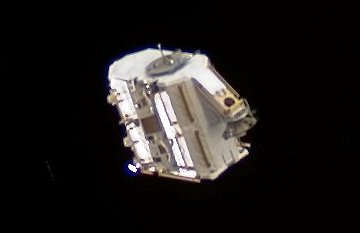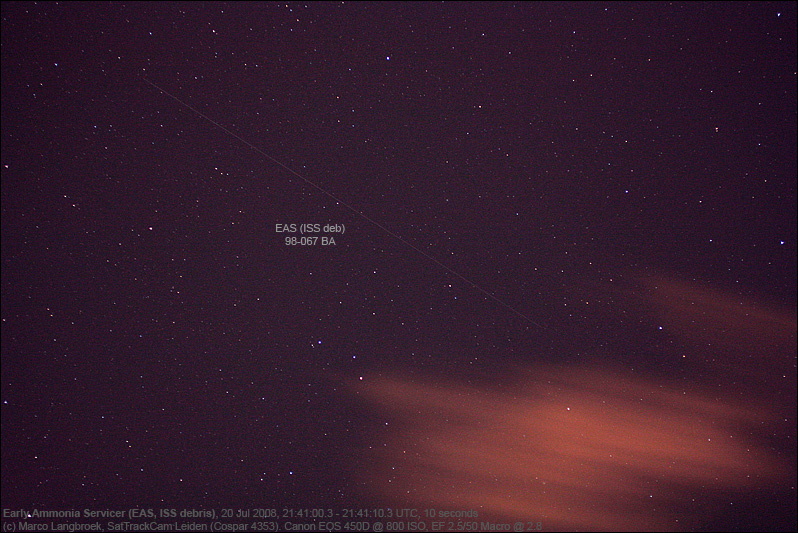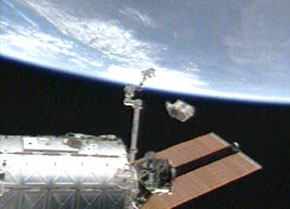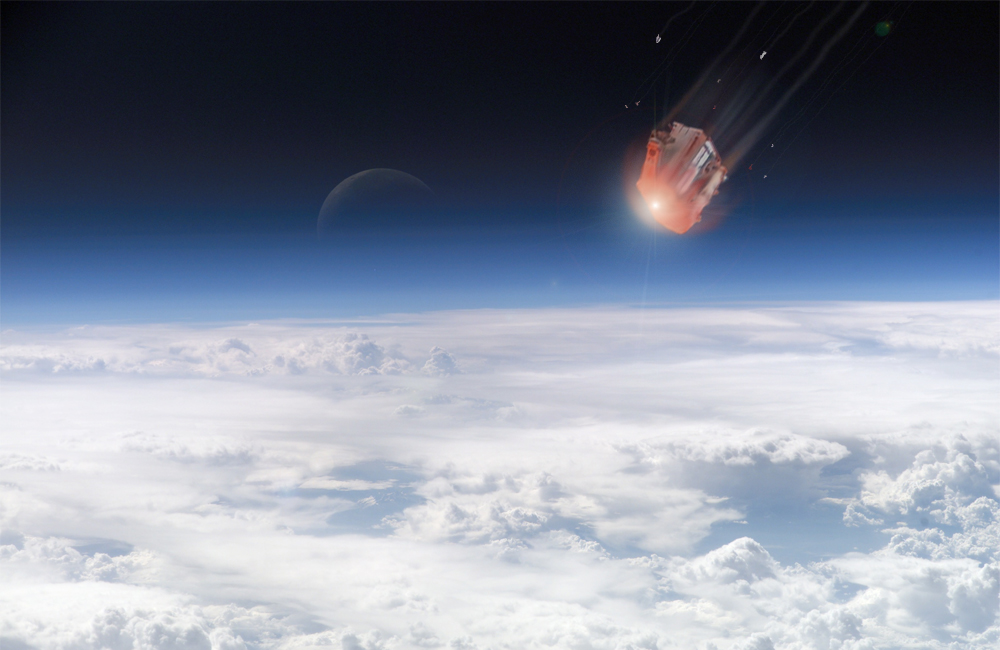|
Space Debris |
||
|
..
The Easy Ammonia Servicer (EAS) photographed on July 23rd, 2007, by ISS astronauts. Now this would put a huge dent in your windshield Written by Ian O'Neill
A huge piece of space debris, weighing 1400 lb (635 kg) and the size of two refrigerators, is gradually falling to Earth, giving observers on the ground a great opportunity to see it. The junk was jettisoned from the International Space Station (ISS) in 2007 and it is expected to re-enter the atmosphere later this year or early 2009. The Early Ammonia Servicer (EAS) was dropped from the ISS after a seven hour spacewalk and pushed in the opposite direction of the space station's orbit shortly before a re-boost by a Soyuz resupply vehicle. This ensured the EAS would pose no danger to the ISS or crew on future orbits. Now the container is beginning its final few months in space and the bets are on as to where it will crash to Earth… When the EAS, filled with ammonia coolant, had served its purpose the ISS crew had little choice but to throw it overboard. Astronaut Clay Anderson led the July 23rd 2007 operation with the assistance of cosmonauts Fyodor Yurchikhin and robotic arm operator Oleg Kotov as they shoved the EAS Earth-ward along with a 212 lb (96 kg) stanchion used to attach a camera to the station. The whole EVA lasted 7 hours and 41 minutes and the EAS was noted as the largest single piece of junk dropped from the ISS. At the time, mission control estimated that the EAS would orbit the Earth for 300 days; obviously this was a huge underestimate as it continues to spiral closer to the atmosphere one year after the mission.
Observing the EAS The EAS is a huge piece of debris and easily tracked from the ground and poses no threat to missions, but it may be a hazard if, as expected, a large portion of the equipment survives re-entry. Dangers aside for now, the EAS is providing amateur astronomers with a new target to point their telescopes at. When the EAS was jettisoned, it was barely visible to the naked eye as it sped overhead with a magnitude of +4 to +4.5. Two days ago on July 20th, veteran satellite observer Marco Langbroek of Leiden, the Netherlands reported observing the EAS at an observable magnitude of +2.0. But it is moving very fast due to its decreased altitude. Currently, the EAS can be seen over Europe, and next week North America will be able to spot it. For information on where and when to look for a chance to observe this huge lump of waste from the ISS, check out SpaceWeather.com's Simple Satellite Tracker before it starts to flirt with our upper atmosphere in the next few months. SOURCE: Universe Today |
||
|
..
Flight Engineer Clay Anderson jettisons the Early Ammonia Servicer. By By Tariq Malik
A piece of space station trash the size of a refrigerator is poised to plunge through the Earth’s atmosphere late Sunday, more than a year after an astronaut tossed it overboard. NASA and the U.S. Space Surveillance Network are tracking the object - a 1,400-pound (635-kg) tank of toxic ammonia coolant thrown from the International Space Station - to make sure it does not endanger people on Earth. Exactly where the tank will inevitably fall is currently unknown, though it is expected to re-enter Earth’s atmosphere Sunday afternoon or later that evening, NASA officials said. “This has got a very low likelihood that anybody will be impacted by it,” said Mike Suffredini, NASA’s space station program manager, in an interview. “But still, it is a large object and pieces will enter and we just need to be cautious.” NASA astronaut Clayton Anderson threw the ammonia tank from the tip of the space station’s Canadian-built robotic arm during a July 23, 2007 spacewalk. He also tossed away an unneeded video camera stand overboard as well, but that 212-pound (96-kilogram) item burned up harmlessly in the atmosphere early this year, Suffredini said. NASA expects up to 15 pieces of the tank to survive the searing hot temperatures of re-entry, ranging in size from about 1.4 ounces (40 grams) to nearly 40 pounds (17.5 kg). If they reach all the way to land, the largest pieces could slam into the Earth’s surface at about 100 mph (161 kph). But a splashdown at sea is also possible, as the planet is two-thirds ocean. “If anybody found a piece of anything on the ground Monday morning, I would hope they wouldn’t get too close to it,” Suffredini said. Known as the Early Ammonia Servicer (EAS), the coolant tank is the largest piece of orbital trash ever tossed overboard by hand from the space station. Larger unmanned Russian and European cargo ships are routinely destroyed in the Earth’s atmosphere over the Pacific Ocean after their space station deliveries, but those disposals are controlled and preplanned. The recent destruction of the European Space Agency’s Jules Verne cargo ship was eagerly observed by scientists hoping to glean new information on how objects behave as they enter Earth’s atmosphere. Observers aboard two chase planes caught photographs and video of the double-decker bus-sized spacecraft’s demise, but no such campaign is possible with the returning ammonia tank. The last object to re-enter the Earth’s atmosphere with prior notice was a small asteroid the size of a kitchen table that exploded in midair as it flew over Africa on Oct. 7. It’s taken more than year for the ammonia tank to slowly slip down toward Earth due to atmospheric drag. During its time aboard the station, the tank served as a coolant reservoir to boost the outpost’s cooling system in the event of leaks. Upgrades to the station last year made the tank obsolete, and engineers were concerned that its structural integrity would not withstand a ride back to Earth aboard a NASA space shuttle. Instead, they tossed it overboard, or “jettisoned” it in NASA parlance. Suffredini said that while astronauts have accidentally lost a tool or two during spacewalks, the planned jettison of larger items is done with the utmost care to ensure the trash doesn’t hit the station or any other spacecraft as it circles the Earth. Engineers also make sure the risk to people on Earth is low, as well. “As a matter of course, we don’t throw things overboard haphazardly,” Suffredini said. “We have a policy that has certain criteria we have to meet before you can throw something overboard.” In the event the tank re-enters over land, NASA advised members of the public to contact their local authorities, or the U.S. Department of State via diplomatic channels if outside the U.S., if they believe they’ve found its remains. SOURCE: SPACE.com |
||
Related
Links:
|
||
|
||
| FAIR USE NOTICE: This page contains copyrighted material the use of which has not been specifically authorized by the copyright owner. Pegasus Research Consortium distributes this material without profit to those who have expressed a prior interest in receiving the included information for research and educational purposes. We believe this constitutes a fair use of any such copyrighted material as provided for in 17 U.S.C § 107. If you wish to use copyrighted material from this site for purposes of your own that go beyond fair use, you must obtain permission from the copyright owner. | ||
|
|




